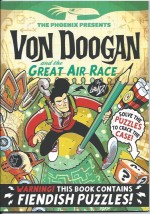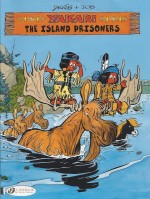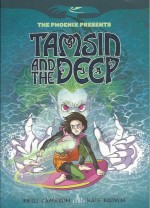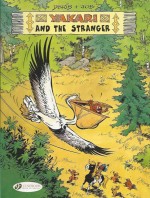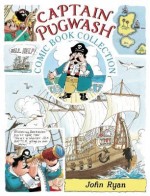
By John Ryan (Frances Lincoln Children’s Books)
ISBN: 978-1-84780-384-9
John Ryan was an artist and storyteller who straddled three distinct disciplines of graphic narrative, with equal qualitative if not financial success. The son of a diplomat, Ryan was born in Edinburgh on March 4th 1921, and undertook his military service in Burma and India. After being de-mobbed and attending the Regent Street Polytechnic from 1946 to 1948, he took up a post as assistant Art Master at Harrow School from 1948 to 1955. It was during this time that he began contributing strips to Fulton Press publications.
On April 14th 1950 Britain’s grey, post-war gloom was partially lifted with the first issue of a new comic that literally gleamed with light and colour. Avid children were soon understandably enraptured; blown away by the gloss and dazzle of Dan Dare, Pilot of the Future, a charismatic star-turn venerated to this day as well as a host of other spectacularly illustrated stories strips and features.
The Eagle was a tabloid-sized paper with full-colour inserts alternating with text and a range of various other comic features. “Tabloid†is a really big page and you can fit a lot of material onto each one. Deep within, on the bottom third of a monochrome page, was an 8-panel strip entitled ‘Captain Pugwash – The story of a Bad Buccaneer and the many Sticky Ends which nearly befell him’ delivered with dash and aplomb by the aforementioned Mr. Ryan.
The indefatigable artist’s quirkily effective, welcomingly spiky style also lent itself to the numerous spot illustrations required throughout the comic every week and he even found time to regularly produce ‘Lettice Leefe, the Greenest Girl in School’ for Eagle‘s distaff companion comic Girl.
Pugwash, his harridan of a wife and the useless, lazy crew of the Black Pig ran until issue #19 when the feature disappeared.
This was no real hardship as Ryan had been writing and illustrating the incomparable and brilliantly mordant ‘Harris Tweed – Extra Special Agent’; a full page (tabloid, remember, upwards of twenty cram-packed and meticulously detail-stuffed panels per huge page, per week) from The Eagle #16 onwards.
Tweed ran for three years as a full page until 1953 when it dropped to a half-page strip and was repositioned as a purely comedic venture.
In 1956 the indefatigable old salt (I’m referring to Horatio Pugwash, but it could so easily be Ryan: an unceasing story-peddler with a big family, he still found time to be head cartoonist at the Catholic Herald for four decades) made the jump to children’s picture books and animated features for television.
The not-so-scurvy seadog washed up next in A Pirate Story: a proper illustrated children’s book and the first official first Pugwash chronicle. It was originally published by Bodley Head before the budding franchise switched to children’s publishing specialist Puffin. It was the first of a vast (sorry nautical puns are contagious, they really, really Arrr!) run of children’s books on a number of different subjects. Pugwash himself starred in 21 tomes; there were a dozen books based on the animated TV series Ark Stories, as well as Sir Prancelot and numerous other inspired creations.
Ryan worked whenever he wanted to in the comic world and eventually the books and the strips began to cross-fertilise.
When A Pirate Story was released in 1957, the BBC wisely pounced on the property, commissioning Ryan to produce a series of 5-minute black-&-white cartoon episodes (86 in all from 1957 to 1968, which were later reformatted in full colour and rebroadcast in 1976). In the budding 1950s arena of animated television cartoons, Ryan developed an entirely new system for producing cheap, high-quality animations to a tremendously tight deadline.
Naturally he began with Pugwash, keeping the adventure milieu, but replaced the Captain’s shrewish wife with a tried-and-true boy assistant. Tom the Cabin Boy is the only capable member of an astoundingly affable and inept crew which included such visual archetypes as Willy, Pirate Barnabas and Master Mate (fat, thin and tall – all dim and not at all bloodthirsty) instantly affirming to the rapt, young audience that grown-ups are fools and kids do, in fact, rule.
Ryan also drew a weekly Pugwash strip in the Radio Times for eight years, before going on to produce other animated series including Mary, Mungo and Midge, The Friendly Giant and Sir Prancelot, plus adaptations of some of his many children’s books. In 1997 an all new CGI-based Pugwash animated TV series began. There was even a thematic prequel in Admiral Fatso Fitzpugwash, in which it was revealed that the not-so-salty seadog had a medieval ancestor who became England’s First Sea Lord, despite being terrified of water…
John Ryan returned to pirate life in the 1980s, drawing new Pugwash storybooks. In swift succession he released The Secret of the San Fiasco, The Battle of Bunkum Bay and The Quest of the Golden Handshake, all joyously gathered in this resoundingly ample (194 x 254 mm) full-colour paperback…
The first Pugwash storybooks were traditional in format, with blocks of text and single illustrations illuminating a particular moment. By 1982 however the entire affair had evolved into lavishly painted comic strips, with standard word balloons on splendid panoramic double-page spreads or informative and complex layouts of as many as eight panels per page.
A fitting circularity to his careers and a nice treat for us old-fashioned comic drones, this trio of tales finds the master at his most exceptional and opens with The Secret of the San Fiasco, as the somewhat shaky stalwarts of the Black Pig fetch up in not-so-scenic Bogle Bay on Scotland’s wind-lashed Atlantic coast.
Ostensibly in search of a little holiday-break, the lads are actually hunting a fabulous treasure lost since the days of the Armada, when a gold-packed Spanish galleon apparently vanished into a solid cliff-face.
Many clever, greedy people have failed to find the treasure ever since 1588, but Pugwash is certain he will succeed. However as he and the crew check into draughty Bogle Castle, they are struck by the forbidding nature of the place and the sinister aspect of the only attendant, McGroggie the caretaker. They’re not amiss in their suspicions: as he terrifies them with spooky tales they are blissfully unaware that the old scoundrel is working with Pugwash’s arch-enemy Cut-Throat Jake…
After a night of terrifying noises and spooky events the cowardly Captain, Willy, Barnabas and Master Mate are quivering wrecks but intrepid Cabin Boy Tom is on the case and has tracked down the imprisoned Laird, heard the full true story of the San Fiasco’s end and deduced the treasure ship’s final resting place.
Sadly, as he leads his shipmates to the hidden trove, Jake and McGroggie are ready to pounce, but after the villains get away Scot free, the rogues fall out as rogues so often do…
The Pugwash stories are gloriously adrift sometime in the 18th century, never too closely bound by continuity whilst benefiting from many of the most momentous moments of a deliciously pick-&-mix grasp of history.
The wily Captain next bobs up during (another) war between England and France. The Battle of Bunkum Bay sees the seedy seamen sailing to the Pajamah Islands in search of a foundered Spanish bullion ship, but said wreck is slap-bang in the middle of two warring fleets. As has been previously noted, Pugwash is good at plans and sourcing loot, but terrible at keeping secrets, and his endeavours have again been observed by Cut-Throat Jake who follows the treasure-hunters at a cautious distance.
When they all reach the Pajamah Islands, the vile buccaneer hijacks Tom’s brilliant trick to sneak between the combative fleets of British Admiral Sir Splycemeigh-Mainbrace and his French rival Admiral the Marquis de Frilly de Pommes-Frites, but just this once canny Tom has overlooked a flaw in his usually impeccable thinking…
Jake leaves the hapless heroes in a dire death-trap and sails off, only to get calamitously caught up in the middle of the legendarily embarrassing Bunkum Bay maritime disaster, allowing Tom time to save the day and lead the Captain to an unaccustomed profit on his schemes…
Closing the piratical peregrinations is The Quest of the Golden Handshake, wherein our querulous, quivering Captain finds a genuine treasure map at an auction. All too soon though, a bidding-war with nefarious nemesis Cut-Throat Jake turns into a full-blown riot in which the coveted chart is torn a-twain…
Never knowingly daunted, Pugwash and company steal Jake’s half of the map that night but on returning to the safety of the Black Pig are horrified to discover that their rival has had the same idea…
Luckily the brilliant cabin boy had anticipated the move and copied their portion of the priceless document. Heartened and enraptured by thoughts of vast wealth, the crew hastily set sail for the Americas, determined to plunder the fabled Lost Treasure of the Stinkas…
Devious Jake, however, smuggles himself and a burly accomplice aboard, planning to let Pugwash do all the heavy lifting whilst awaiting a golden moment to claim revenge and the loot…
Packed with in-jokes, glorious tom-foolery and daring adventure, the voyage to the New World in a “haunted†ship culminates in a splendid battle of (half) wits before Tom, as usual, saves the day in his quiet, competent and deucedly clever way…
Gripping, hilarious and packed with gloriously effective and educational art of the most eye-catching quality these magically wry and enchantingly smart yarns are amongst Ryan’s very best: a humorous hoard of comic gems for fans of all ages.
We don’t have that many multi-discipline successes in comics, so why don’t you go and find out why we should celebrate one who did it all, did it first and did it well? Your kids will thank you and, if you’ve any life left in your old and weary adult fan’s soul, you will too…
© 1983, 1984, 1985, 1992, 2012 the Estate of John Ryan. All rights reserved.



